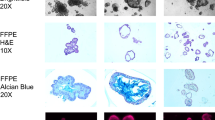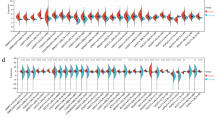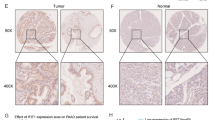Abstract
Most sporadic colorectal cancers (CRCs) develop from preformed adenomas. Cytokines are involved in the transition from adenoma to CRC. Interleukin-33 (IL-33) is a newly discovered proinflammatory cytokine belonging to the IL-1 cytokine family and involved in the development of chronic inflammation and cancer. The aim of this study was to evaluate the dynamics of the IL-33/ST2 axis during the sequence of progression from normal colorectum to adenoma to carcinoma and to investigate the association of IL-33 and ST2 expression with clinicopathological parameters and prognosis. The results demonstrated that the levels of IL-33 and ST2 in adenomas (n = 50), determined by real-time PCR, were significantly higher than those of normal controls (n = 30); the levels of both IL-33/ST mRNA in CRCs (n = 50) were higher than in normal controls but lower than in adenomas. Further analysis revealed that the expression level of ST2 in CRCs was associated with tumor/node/metastasis (TNM) stage. The log-rank test showed that neither the IL-33 nor the ST2 expression level was correlated with overall survival in patients with CRC. The increased expression of IL-33/ST2 in adenomas and CRC tissues was confirmed by immunohistochemistry and was observed in both the tumor stromal cells and adenomatous/cancerous cells. Notably, increased densities of IL-33-positive and ST2-positive microvessels were found in the stroma of adenomas and CRCs. In conclusion, increased expression of the IL-33/ST2 axis along the colorectal adenoma–carcinoma sequence might be involved in the neoplastic transformation via the participation of this axis in the regulation of angiogenesis.





Similar content being viewed by others
Abbreviations
- CRC:
-
Colorectal cancer
- CT:
-
Cycle threshold
- IBD:
-
Inflammatory bowel diseases
- IFN:
-
Interferon
- IHC:
-
Immunohistochemistry
- IL:
-
Interleukin
- LGD:
-
Lower-grade dysplasia
- HGD:
-
High-grade dysplasia
- HPF:
-
High-power fields
- MGD:
-
Moderate-grade dysplasia
- MVD:
-
Microvessel densities
- PCR:
-
Polymerase chain reaction
- SEM:
-
Mean of standard error
- Th:
-
T helper
- TNF:
-
Tumor necrosis factor
- TNM:
-
Tumor/node/metastasis
References
Fearon ER, Vogelstein B (1990) A genetic model for colorectal tumorigenesis. Cell 61:759–767
Leslie A, Carey FA, Pratt NR, Steele RJ (2002) The colorectal adenoma-carcinoma sequence. Br J Surg 89:845–860
Khosraviani K (1996) Colorectal adenoma-carcinoma sequence. Gut 39:342
Xie K (2001) Interleukin-8 and human cancer biology. Cytokine Growth Factor Rev 12:375–391
Cacev T, Radosevic S, Krizanac S, Kapitanovic S (2008) Influence of interleukin-8 and interleukin-10 on sporadic colon cancer development and progression. Carcinogenesis 29:1572–1580
Waugh DJ, Wilson C (2008) The interleukin-8 pathway in cancer. Clin Cancer Res 14:6735–6741
Fantini MC, Pallone F (2008) Cytokines: from gut inflammation to colorectal cancer. Curr Drug Targets 9:375–380
Choi JW, Liu H, Shin DH, Yu GI, Hwang JS, Kim ES, Yun JW (2013) Proteomic and cytokine plasma biomarkers for predicting progression from colorectal adenoma to carcinoma in human patients. Proteomics 13:2361–2374
Chung YC, Chang YF (2003) Significance of inflammatory cytokines in the progression of colorectal cancer. Hepatogastroenterology 50:1910–1913
Kang M, Edmundson P, Araujo-Perez F, McCoy AN, Galanko J, Keku TO (2013) Association of plasma endotoxin, inflammatory cytokines and risk of colorectal adenomas. BMC Cancer 13:91
Kim S, Keku TO, Martin C, Galanko J, Woosley JT, Schroeder JC, Satia JA, Halabi S, Sandler RS (2008) Circulating levels of inflammatory cytokines and risk of colorectal adenomas. Cancer Res 68:323–328
Krzystek-Korpacka M, Diakowska D, Kapturkiewicz B, Bebenek M, Gamian A (2013) Profiles of circulating inflammatory cytokines in colorectal cancer (CRC), high cancer risk conditions, and health are distinct. Possible implications for CRC screening and surveillance. Cancer Lett 337:107–114
Cui G, Goll R, Olsen T, Steigen SE, Husebekk A, Vonen B, Florholmen J (2007) Reduced expression of microenvironmental Th1 cytokines accompanies adenomas-carcinomas sequence of colorectum. Cancer Immunol Immunother 56:985–995
Cui G, Yuan A, Goll R, Vonen B, Florholmen J (2009) Dynamic changes of interleukin-8 network along the colorectal adenoma-carcinoma sequence. Cancer Immunol Immunother 58:1897–1905
Oliveira Frick V, Rubie C, Ghadjar P, Faust SK, Wagner M, Graber S, Schilling MK (2011) Changes in CXCL12/CXCR4-chemokine expression during onset of colorectal malignancies. Tumour Biol 32:189–196
Pellegrini P, Berghella AM, Contasta I, Del Beato T, Adorno D (2006) The study of a patient’s immune system may prove to be a useful noninvasive tool for stage classification in colon cancer. Cancer Biother Radiopharm 21:443–467
Liew FY (2012) IL-33: a Janus cytokine. Ann Rheum Dis 71(Suppl 2):i101–i104
Beltran CJ, Nunez LE, Diaz-Jimenez D, Farfan N, Candia E, Heine C, Lopez F, Gonzalez MJ, Quera R, Hermoso MA (2010) Characterization of the novel ST2/IL-33 system in patients with inflammatory bowel disease. Inflamm Bowel Dis 16:1097–1107
Milovanovic M, Volarevic V, Radosavljevic G, Jovanovic I, Pejnovic N, Arsenijevic N, Lukic ML (2012) IL-33/ST2 axis in inflammation and immunopathology. Immunol Res 52:89–99
Kobori A, Yagi Y, Imaeda H, Ban H, Bamba S, Tsujikawa T, Saito Y, Fujiyama Y, Andoh A (2010) Interleukin-33 expression is specifically enhanced in inflamed mucosa of ulcerative colitis. J Gastroenterol 45:999–1007
Jovanovic IP, Pejnovic NN, Radosavljevic GD, Arsenijevic NN, Lukic ML (2012) IL-33/ST2 axis in innate and acquired immunity to tumors. Oncoimmunology 1:229–231
Eiwegger T, Akdis CA (2011) IL-33 links tissue cells, dendritic cells and Th2 cell development in a mouse model of asthma. Eur J Immunol 41:1535–1538
Schmieder A, Multhoff G, Radons J (2012) Interleukin-33 acts as a pro-inflammatory cytokine and modulates its receptor gene expression in highly metastatic human pancreatic carcinoma cells. Cytokine 60:514–521
Chen SF, Nieh S, Jao SW, Wu MZ, Liu CL, Chang YC, Lin YS (2013) The paracrine effect of cancer-associated fibroblast-induced interleukin-33 regulates the invasiveness of head and neck squamous cell carcinoma. J Pathol 231:180–189
Zhang P, Liu XK, Chu Z, Ye JC, Li KL, Zhuang WL, Yang DJ, Jiang YF (2012) Detection of interleukin-33 in serum and carcinoma tissue from patients with hepatocellular carcinoma and its clinical implications. J Int Med Res 40:1654–1661
Hu LA, Fu Y, Zhang DN, Zhang J (2013) Serum IL-33 as a diagnostic and prognostic marker in non- small cell lung cancer. Asian Pac J Cancer Prev 14:2563–2566
Sun P, Ben Q, Tu S, Dong W, Qi X, Wu Y (2011) Serum interleukin-33 levels in patients with gastric cancer. Dig Dis Sci 56:3596–3601
Musolino C, Allegra A, Profita M, Alonci A, Saitta S, Russo S, Bonanno A, Innao V, Gangemi S (2013) Reduced IL-33 plasma levels in multiple myeloma patients are associated with more advanced stage of disease. Br J Heamatol 160:709–710
Seidelin JB, Rogler G, Nielsen OH (2011) A role for interleukin-33 in T(H)2-polarized intestinal inflammation? Mucosal Immunol 4:496–502
Cui G, Olsen T, Christiansen I, Vonen B, Florholmen J, Goll R (2006) Improvement of real-time polymerase chain reaction for quantifying TNF-alpha mRNA expression in inflamed colorectal mucosa: an approach to optimize procedures for clinical use. Scand J Clin Lab Inv 66:249–259
Cui G, Koh TJ, Chen D, Zhao CM, Takaishi S, Dockray GJ, Varro A, Rogers AB, Fox JG, Wang TC (2004) Overexpression of glycine-extended gastrin inhibits parietal cell loss and atrophy in the mouse stomach. Cancer Res 64:8160–8166
Cui J, Xu G, Liu J, Pang Z, Florholmen J, Cui G (2013) The expression of non-mast histamine in tumor associated microvessels in human colorectal cancers. Pathol Oncol Res 19:311–316
Jovanovic IP, Pejnovic NN, Radosavljevic GD, Pantic JM, Milovanovic MZ, Arsenijevic NN, Lukic ML (2014) Interleukin-33/ST2 axis promotes breast cancer growth and metastases by facilitating intratumoral accumulation of immunosuppressive and innate lymphoid cells. Int J Cancer 134:1669–1682
Kuchler AM, Pollheimer J, Balogh J, Sponheim J, Manley L, Sorensen DR, De Angelis PM, Scott H, Haraldsen G (2008) Nuclear interleukin-33 is generally expressed in resting endothelium but rapidly lost upon angiogenic or proinflammatory activation. Am J Pathol 173:1229–1242
Contasta I, Berghella AM, Pellegrini P, Adorno D (2003) Passage from normal mucosa to adenoma and colon cancer: alteration of normal sCD30 mechanisms regulating TH1/TH2 cell functions. Cancer Biother Radiopharm 18:549–557
Marvie P, Lisbonne M, L’Helgoualc’h A, Rauch M, Turlin B, Preisser L, Bourd-Boittin K, Theret N, Gascan H, Piquet-Pellorce C, Samson M (2010) Interleukin-33 overexpression is associated with liver fibrosis in mice and humans. J Cell Mol Med 14:1726–1739
Meephansan J, Tsuda H, Komine M, Tominaga S, Ohtsuki M (2012) Regulation of IL-33 expression by IFN-gamma and tumor necrosis factor-alpha in normal human epidermal keratinocytes. J Invest Dermatol 132:2593–2600
Byrne SN, Beaugie C, O’Sullivan C, Leighton S, Halliday GM (2011) The immune-modulating cytokine and endogenous Alarmin interleukin-33 is upregulated in skin exposed to inflammatory UVB radiation. Am J Pathol 179:211–222
Seltmann J, Werfel T, Wittmann M (2013) Evidence for a regulatory loop between IFN-gamma and IL-33 in skin inflammation. Exp Dermatol 22:102–107
Gschwantler M, Kriwanek S, Langner E, Goritzer B, Schrutka-Kolbl C, Brownstone E, Feichtinger H, Weiss W (2002) High-grade dysplasia and invasive carcinoma in colorectal adenomas: a multivariate analysis of the impact of adenoma and patient characteristics. Eur J Gastroenterol Hepatol 14:183–188
Ajdukovic J, Tonkic A, Salamunic I, Hozo I, Simunic M, Bonacin D (2010) Interleukins IL-33 and IL-17/IL-17A in patients with ulcerative colitis. Hepatogastroenterology 57:1442–1444
Seidelin JB, Bjerrum JT, Coskun M, Widjaya B, Vainer B, Nielsen OH (2010) IL-33 is upregulated in colonocytes of ulcerative colitis. Immunol Lett 128:80–85
Choi YS, Choi HJ, Min JK, Pyun BJ, Maeng YS, Park H, Kim J, Kim YM, Kwon YG (2009) Interleukin-33 induces angiogenesis and vascular permeability through ST2/TRAF6-mediated endothelial nitric oxide production. Blood 114:3117–3126
Acknowledgments
This research was supported by grants from the Medical Research Program of Northern Norway Regional Health Authority (Grant No. SFP-44-04) and the National Natural Science Foundation of China (Grant No. 81071969).
Conflict of interest
All authors declare no conflicts of interest.
Author information
Authors and Affiliations
Corresponding author
Rights and permissions
About this article
Cite this article
Cui, G., Qi, H., Gundersen, M.D. et al. Dynamics of the IL-33/ST2 network in the progression of human colorectal adenoma to sporadic colorectal cancer. Cancer Immunol Immunother 64, 181–190 (2015). https://doi.org/10.1007/s00262-014-1624-x
Received:
Accepted:
Published:
Issue Date:
DOI: https://doi.org/10.1007/s00262-014-1624-x




